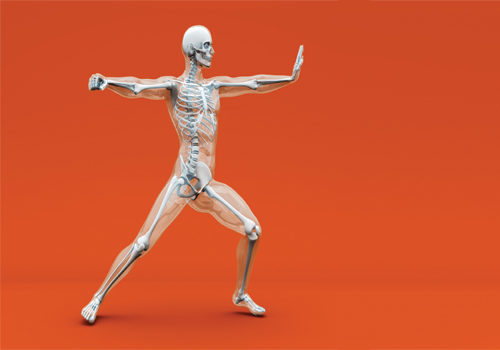Minor aches and pains are normal parts of life. But chronic pain and stiffness that stops us from doing the things we love aren’t. Here, we cover the many ways to strengthen the body’s support system via nutritional and lifestyle techniques to keep the bones strong and joint movement fluid.
If shoppers are looking for bone strengtheners and natural arthritis remedies, let them know supplements can't be said to cure or prevent disease. Nonetheless, there are numerous natural ways to maintain optimal bone and joint health.
I’m Losing It!
We often hear that childhood and adolescence are the best times to invest in bone health. By age 18 for girls and age 20 for boys, as much as 90% of one’s peak bone mass is built (1). Many believe the situation goes downhill from here, as bone strength and density deplete after age 30 (1). But is this really the end of the story?
“It’s never too late (or too early) to start building healthy bones,” states Cheryl Myers, head of education and scientific affairs at EuroPharma, Inc., Green Bay, WI.
She explains that the body continuously builds up and breaks down bone tissue. While the foundation of our bone mass is acquired earlier in life, bones go through a normal life cycle, and it is key we provide them the nutrients and support they need to thrive at all ages.
This support, says Parris M. Kidd, Ph.D., chief science officer at Doctor’s Best Inc., San Clemente, CA, means doing what it takes to add bone mass and reduce bone mass loss.
Achieving this involves many factors, including 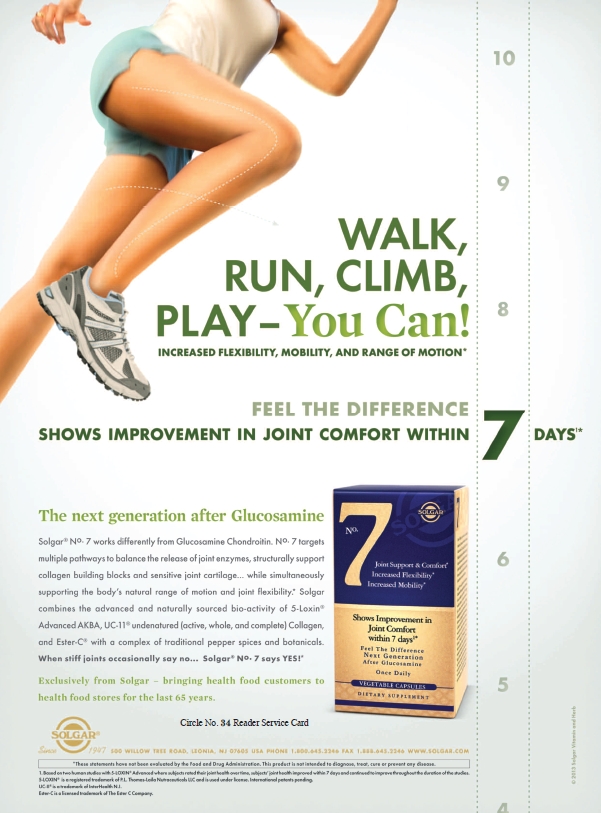 blood acidity—something few know is linked with bone mass. Blood can become too acidic from dietary factors, like eating too much refined sugar, white flour, soda or animal protein. Lou Paradise, president and chief of research at Topical BioMedics, Inc., Rhinebeck, NY, says having too much acid in the blood upsets the pH alkaline balance necessary to maintain healthy bone density. “The body will use alkaline minerals from the bones to counteract the acidity, and losing bone mass is the result,” he states.
blood acidity—something few know is linked with bone mass. Blood can become too acidic from dietary factors, like eating too much refined sugar, white flour, soda or animal protein. Lou Paradise, president and chief of research at Topical BioMedics, Inc., Rhinebeck, NY, says having too much acid in the blood upsets the pH alkaline balance necessary to maintain healthy bone density. “The body will use alkaline minerals from the bones to counteract the acidity, and losing bone mass is the result,” he states.
For this reason, Paradise feels consumers should first address metabolic issues related to the diet: “It can start with consuming more alkalizing vegetables and fruits and reducing the intake of refined sugar, flour and other acid-producing food groups.”
Another factor, says Kidd, is estrogen decline. He points out that while the effect of decreased estrogen levels is “mostly well researched as a peri-menopausal phenomenon, it also occurs in young women due to (for example) ‘athletic amenorrhea’ or low-estrogen oral contraceptive use.” Thus, bone loss can start at any age. He adds that smoking, excessive drinking, sustained steroid use and various inflammatory states all could result in bone loss.
Also contributing to bone loss is a sedentary lifestyle, especially one concentrated indoors. Nena Dockery, technical services manager for Membrell, Carthage, MO, says cutting out time in the sun reduces our vitamin D levels, which could negatively affect calcium absorption. Plus, missing out on regular exercise is detrimental to bone mass.
“When we exercise, the muscle stresses the bone and the bones increase density to maintain the workload, thereby maintaining bone mass and healthy joints,” Paradise explains. He feels walking is especially beneficial because it affects the largest bones of the body.
Sadly, some factors are outside our control, like genetics. Says Dockery, “By the time we reach adulthood, our gender, ethnicity, body build and levels of crucial hormones have all begun to exert their influence in determining the strength and density of our bones as we begin to age, and our control over these elements is minimal.”
But Michael T. Murray, N.D., director of product development and education at Natural Factors Nutritional Products, Inc., Everett, WA, says we can’t let ourselves use “bad genes” as an excuse for letting bone health slide. “As significant as genetic factors are in osteoporosis risk, there is no question that the major determinants of bone health are diet and lifestyle,” he states. “Osteoporosis in most cases is an entirely preventable disease through diet, lifestyle and proper supplementation.”
The Calcium Conundrum
The diet–bone health discussion often begins in the same way: calcium supports healthy bones. But, it warrants repeating that the good this mineral can do for our skeletal structure doesn’t exist in a vacuum. Rather, calcium—whether acquired through foods or supplements—is most beneficial in combination with other elements.
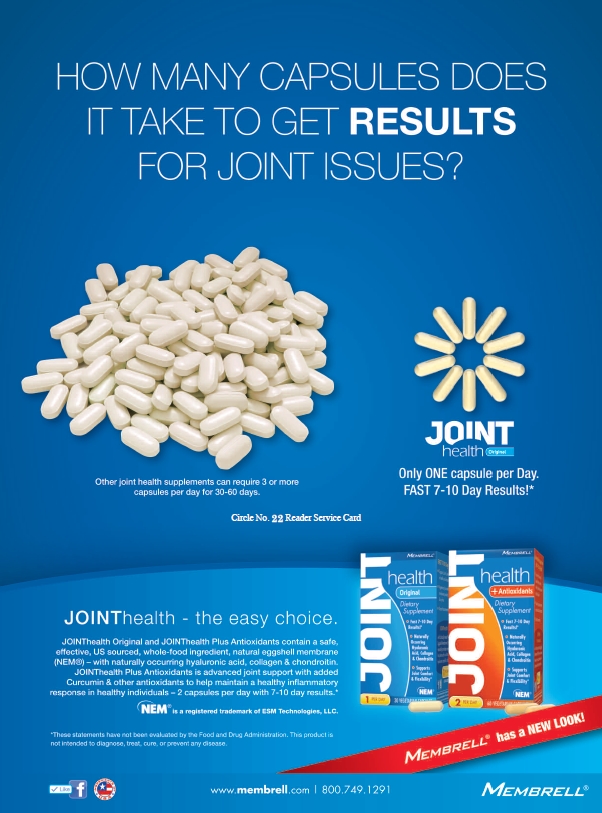 “Way too much attention is given to calcium in regards to bone health. Calcium alone has very little benefit in protecting against osteoporosis; it requires vitamin D and many other nutrients,” says Murray.
“Way too much attention is given to calcium in regards to bone health. Calcium alone has very little benefit in protecting against osteoporosis; it requires vitamin D and many other nutrients,” says Murray.
Myers also feels that moderate levels of calcium intake are preferable, but at the same time, she believes, “the quantity of calcium is not as important as the quality.”
For instance, some forms may be more absorbable than others. Myers prefers chelated minerals for optimal absorption.
Another option in the calcium arena is natural eggshell calcium, which Dockery says has some advantages over other supplemental forms of calcium. “Because it contains a higher level of elemental calcium, the daily dose for [supplements with natural eggshell calcium such as our] BONEhealth Original is smaller than most encapsulated calcium products,” she states, noting that studies indicate this ingredient is well absorbed through the intestines and effective at increasing bone mass.
The bottom line: be sure shoppers know to take a calcium that works for them, in moderation, and in combination with appropriate metabolizers.
D-lightful
One of the best-known calcium compadres is vitamin D. Unfortunately, it’s been pretty well established that most Americans have low levels of D in their systems. “Without a doubt, the most important research finding on bone health has been the persistent discovery of low serum D levels across the U.S. population,” states Angelica Vrablic, Ph.D., manager of nutrition research at Solgar, Leonia, NJ. “National survey data show that Americans’ vitamin D intakes do not meet their dietary requirements for optimal health, and we know that lack of exposure to sunlight and use of sunscreens can also negatively affect serum D levels.”
This isn’t good news, especially because vitamin D is so important to our bodies, including for skeletal health. Murray tells us that research now suggests a direct correlation between bone density and levels of vitamin D3 in the blood.
Dallas L. Clouatre, Ph.D., R&D consultant to Jarrow Formulas, Inc., Los Angeles, CA, describes this relationship as “elaborate and complicated.” Once broken down into 1,25(OH)2D in the body, D interacts with a receptor in the small intestine to increase calcium absorption in the intestines (2). Plus, says Clouatre, it “plays a role in the actions of osteoblasts to secrete what is known as RANKL [receptor activator of nuclear factor-KB ligand], which activates osteoclasts in the bone-remodeling process.” It also helps regulate phosphorus loss, which supports the formation of hydroxyapatite in bones.
In addition, Clouatre says when vitamin D circulates in the blood, it causes the parathyroid hormone to reduce bone resorption. In the end, he says, all these factors help in the bone creation process, and Kidd believes this leads to a compelling benefit: “The higher the blood level of vitamin 1,25D (calcitriol), up to 45 ng/mL (112 nM/L), the lower the risk for bone fracture” (3).
How much vitamin D should one take? While the Institute of Medicine says 600 IU/day is appropriate for many healthy individuals (depending on their age), some industry members feel that even higher levels can be safely taken. Murray, for instance, suggests 2,000 IU/day for general health, and 5,000 IU/day for those with reduced bone density or osteoporosis. Pregnant and lactating women can use extra vitamin D, too. “In the past, breastfeeding longer than six months was considered a cause of vitamin D deficiency in children,” he states. “We now know that the problem is not breastfeeding, but rather that almost all women are deficient in vitamin D.”
Before leaving our discussion of vitamin D, 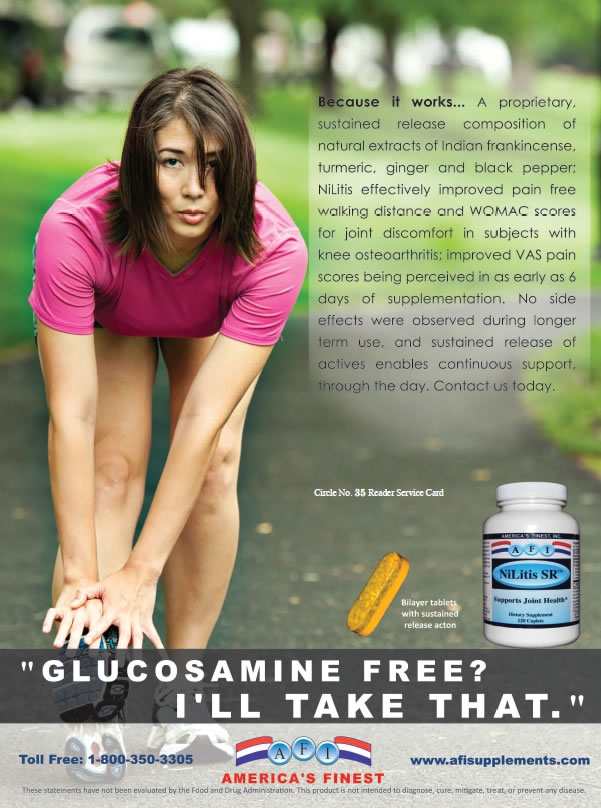 note that this supplement may support much more than just the skeletal system. According to Trisha Sugarek MacDonald, B.S., M.S., director of research and development/national educator, Bluebonnet Nutrition Corporation, Sugar Land, TX, “It has also been reported in various experimental and epidemiologic studies, as well as clinical trials that adequate vitamin D levels are crucial for supporting immune, cellular and urinary tract health, as well as for modulating mood and controlling various hormone systems.”
note that this supplement may support much more than just the skeletal system. According to Trisha Sugarek MacDonald, B.S., M.S., director of research and development/national educator, Bluebonnet Nutrition Corporation, Sugar Land, TX, “It has also been reported in various experimental and epidemiologic studies, as well as clinical trials that adequate vitamin D levels are crucial for supporting immune, cellular and urinary tract health, as well as for modulating mood and controlling various hormone systems.”
Minerals Matter
You’d be doing shoppers a disservice if you give them vitamin D and calcium for bone support without offering information about other key items in the category.
Clouatre points to a 2011 study showing that women received some positive benefits from supplemental calcium with D (e.g., decreased the risk of total, breast, and colorectal cancers), but there wasn’t much effect on fracture risk (4). The other looked at calcium alone, and found gradual increases in dietary calcium intake weren’t associated with further reductions in fracture risk or osteoporosis in women (5).
So, it’s important to think about combinations of other bone-supporting nutrients, too, particularly from the mineral family. For starters, there’s magnesium. “Magnesium is the fourth most abundant mineral in the body, and approximately 50% of the body’s magnesium is found in the bones,” says Vrablic.
Steve Holtby, president and CEO of Soft Gel Technologies, Inc. (SGTI), Los Angeles, CA, explains that this mineral supports calcium and vitamin D metabolism, and the body needs magnesium and calcium in balance to be effective. He states, “Calcium acts to help neurotransmission for muscle contraction, while magnesium may help to function in an opposite way, for relaxation.” An imbalance can cause problems.
Ken Whitman, president of Natural Vitality, Austin, TX, reminds us that the ideal balance of calcium and magnesium is 1:1, while many people’s ratios are 5:1 or more. “As with most things in life, balance is important. We all know that ‘too much of a good thing’ can be detrimental and that is certainly the case with too much calcium,” states Whitman.
Carolyn Dean, M.D., N.D., medical director of the Nutritional Magnesium Association and author of The Magnesium Miracle, says if calcium intake is too high and magnesium is too low, it creates stress within the body and the excess calcium will not be used correctly. “Magnesium keeps calcium dissolved in the blood. Too much calcium and too little magnesium can cause some forms of arthritis, kidney stones, osteoporosis and calcification of the arteries, leading to heart attack and cardiovascular disease,” she states (6).
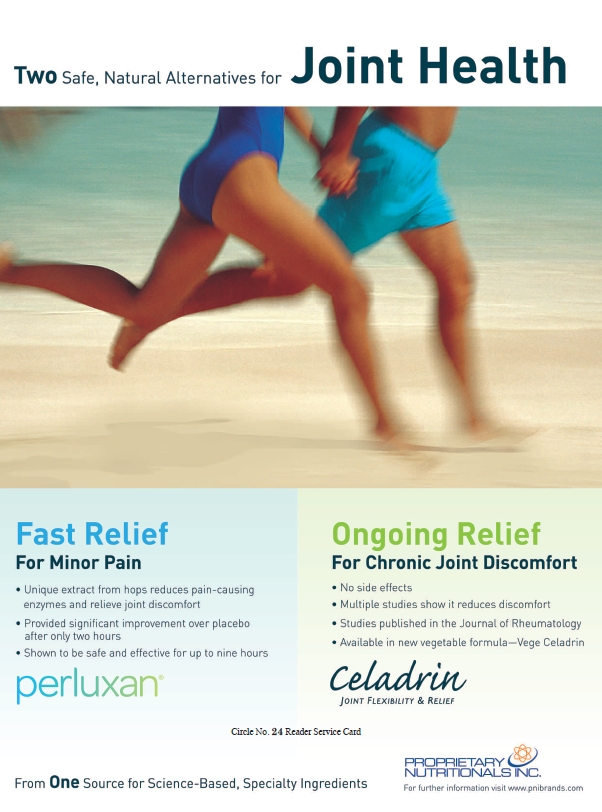 In Vrablic’s eyes, retailer education about the importance of magnesium for bone health is essential, as she feels many shoppers don’t know much about this relationship.
In Vrablic’s eyes, retailer education about the importance of magnesium for bone health is essential, as she feels many shoppers don’t know much about this relationship.
Moving on to other minerals and elements, Myers believes strontium doesn’t get the attention it deserves for maintaining bone strength and density. She says, “It’s a critical—and often ignored—component for enhancing bone mineral density. For absorbability, it is best taken two hours before or two hours after a calcium supplement.”
Other important bone health minerals include phosphorus, manganese, zinc (spurs bone formation and reduces bone resorption), copper, boron (helps with estrogen metabolism and protecting against osteoporosis) and one that recently is getting a lot of attention for bone health: silica. States Paradise, “There are new findings coming from some scientific circles looking at the collagen component of bone health where silica is a main support factor. Silica builds bone collagen, yet is deficient in a typical diet here in the United States.”
The collagen connection. Timothy Mount, CN, CCMH, national educator for NeoCell, Santa Ana, CA, starts us off by explaining the importance of collagen with this fact: bones are made of 36% collagen. “Without collagen, calcium has nowhere to go,” he says, giving us a great analogy: years ago, builders would pour cement to lay a home’s foundation, only to find it would crack easily. They learned in time that adding rebar (i.e., a mesh of steel wires) made the cement foundation strong and durable.
“Collagen fibrils in the bone act much like rebar in the foundation of a house,” he states. “The calcium and other minerals in a bone need collagen to hold it in place as well.” This matrix is key for keeping the minerals that make up healthy bones in place, and it also gives bone a certain amount of flexibility, which reduces the risk of fracture. Mount adds, “Without collagen, bones are brittle and weak, and the reduced matrix of collagen in the bone means there is less space for minerals to be deposited.”
Given this important role that collagen plays, it is scary to note that every year after age 25, our collagen production declines by 1.5%. For this reason, Mount feels collagen “may be the most important supplement a person can take.”
Mount isn’t the only one who believes in collagen. Murray 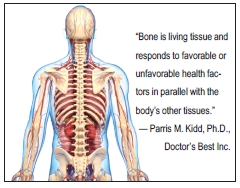 says the most interesting research in bone health focuses on the collagen connection. “Decreased collagen content of the bone is a key underlying factor in osteoporosis and low bone density,” he explains, adding that since the amount of collagen determines the number of bone mineral binding sites, low collagen content makes bone more brittle and the fracture risk increases.
says the most interesting research in bone health focuses on the collagen connection. “Decreased collagen content of the bone is a key underlying factor in osteoporosis and low bone density,” he explains, adding that since the amount of collagen determines the number of bone mineral binding sites, low collagen content makes bone more brittle and the fracture risk increases.
Murray feels that while collagen supplements can provide the building blocks of collagen manufacture, it’s also important to increase the activity of collagen-producing cells. Thus, he suggests a highly bioavailable form of silica (choline stabilized orthosilicic acid or ChOSA [BioSil]) for this purpose. He says researchers have studied ChOSA as a way to help increase collagen production for bone health.
According to Murray, “In a very detailed double-blind study in postmenopausal women with low bone density, ChOSA was able to increase the collagen content of the bone by 22% and increase bone density by 2% within the first year of use. The recommended dosage is 6–10 mg per day.
Very Vital Vitamins
On the vitamin side, K2 (such as menaquinone-7) rightly earns a spot in bone health formulas, and Sugarek MacDonald tells us why: “In the literature, there is growing evidence that vitamin K2 may play a role in the regulation of bone metabolism.”
For instance, a three-year placebo-controlled study by University of Maastricht researchers found vitamin K2 (MK-4) helped maintain bone strength by improving bone mineral content in postmenopausal women (7).
Sugarek MacDonald is careful to note that the K2 form (not the K1) supports bone formation and decreases bone reabsorption, which supports optimal bone health and density.
 She states, “Vitamin K2, not K1, effectively activates the osteoblasts (bone-building cells), which lay down the osteocalcin in the bone, allowing the calcium to bind and making the bones dense and strong. Furthermore, the bone reabsorption cells (osteoclasts) are inhibited, reducing the reabsorption of calcium from the bone to the plasma, thus maintaining optimal density.”
She states, “Vitamin K2, not K1, effectively activates the osteoblasts (bone-building cells), which lay down the osteocalcin in the bone, allowing the calcium to bind and making the bones dense and strong. Furthermore, the bone reabsorption cells (osteoclasts) are inhibited, reducing the reabsorption of calcium from the bone to the plasma, thus maintaining optimal density.”
Clouatre offers some additional information about how vitamin K functions in the body. For instance, it helps activate the Matrix Gla protein (a calcification inhibitor in soft tissues like those of the cardiovascular system). Thus, Sugarek MacDonald warns that without proper levels of vitamin K in the body, calcium may not be properly used by or transported around the body.
Other than K2, it is well known that folic acid may lower homocysteine levels, which is important because high levels are linked to osteoporosis, states Clouatre.
Meanwhile, vitamin C, including forms like Ester-C, offers several bone benefits supports collagen production, which contributes to bone flexibility. American Health included the vitamin in its Ester-C (1,000 mg) with D3 (5,000 IU) combination supplement partly for this reason.
To this, Dockery adds “Vitamin C both suppresses osteoclasts and stimulates the development of osteoblasts. This was in contrast to the standard pharmaceutical treatments for osteoporosis that suppress osteoclast functioning, but do not stimulate osteoblast formation, so no new bone is made”(8).
While no single option works perfectly for everyone, Clouatre suggests a balanced approach that includes calcium may be the most effective option for shoppers. Robert DiSilvestro, Ph.D., of Ohio State University studied a branded combination bone supplement (Bone-Up from Jarrow Formulas) that contains calcium, vitamin D3, vitamin K2 (as MK-7), magnesium and other minerals during an eight-week trial. When compared to a placebo, the supplement “was found to produce statistically significant changes in urinary DPD and alpha-helical peptide (markers of bone degradation), plasma bone specific alkaline phosphatase (a marker of bone synthesis), plasma 1,25(OH)2D (an indicator of vitamin D nutritional status) and plasma parathyroid hormone (a hormone that affects bone metabolism and is affected by calcium nutritional status),” says Clouatre.
Bone/Joint Two-fers?
As we move to joint health, Sugarek MacDonald makes the point that there are several common threads between bone and joint health. For instance, collagen is not only a foundation for bones; it is present in joints, ligaments and cartilage, too. Thus, there could be some crossover between bone support supplements and natural remedies for arthritis and joint care.
Sugarek MacDonald adds, “In addition, the degradation of joints and bones has become a common health concern and can lead to osteoporosis and osteoarthritis (OA).” Speaking of ingredients like glucosamine, chondroitin and MSM, she says that “By employing the right nutrients, the body will be able to repair and maintain cells and tissues for optimal joint health and collagen synthesis that is also required for bone support.”
Also playing for both the bone and joint health teams is vitamin D. In fact, Myers says vitamin D deficiency was found in 69% of patients with inflammatory joint diseases or connective tissue diseases, 77% with soft tissue rheumatism, 62% with OA, 75% with back pain and 71% with osteoporosis (9).
Deterring Damage
So, how does joint damage start in the first place? Joosang Park, vice president of scientific affairs at BioCell Technology, LLC, Newport Beach, CA, says many factors (including genetic makeup and unhealthy lifestyle) can contribute to chronic joint diseases such as OA. Aging, too, is on the list because over time, macromolecular components such as collagen type II and glycosaminoglycans (GAGs) such as hyaluronic acid become depleted. These elements, he says, are “essential for the structure and function of the connective tissue such as the cartilage.”
Being overweight makes for a lot of extra wear and tear on the joints. “Every extra pound of weight adds five pounds of pressure on joints,” says Sugarek MacDonald.
Another factor in long-term joint damage comes from what may seem a safe source: pain-relieving drugs. States Rodney Benjamin, technical director for Bergstrom Nutrition, "These drugs act to mask pain without addressing the cause. This can lead to further injury and damage.
The situation can be helped or hurt by certain food choices. “A poor choice of diet that fails to replenish both collagen and hyaluronic acid does not provide a proper nutrition for gradually vulnerable joint tissues. Various instant foods charged with oxidative and inflammatory insults worsen the problem,” Park believes.
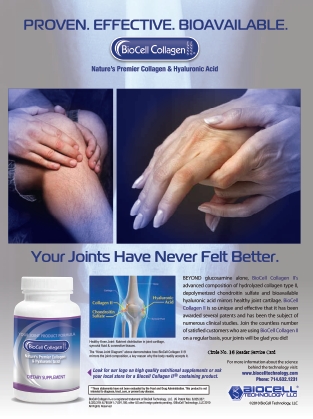 Also missing from too many diets are omega-3s, which spells trouble for the joints. “It is estimated that people are now eating 20 times more omega-6s than omega-3s,” says Holtby. “From a biochemical standpoint, this lopsided imbalance in dietary intake of the omega-6 and omega-3 fatty acids sets the stage for powerful and chronic proinflammatory reactions.”
Also missing from too many diets are omega-3s, which spells trouble for the joints. “It is estimated that people are now eating 20 times more omega-6s than omega-3s,” says Holtby. “From a biochemical standpoint, this lopsided imbalance in dietary intake of the omega-6 and omega-3 fatty acids sets the stage for powerful and chronic proinflammatory reactions.”
And, this imbalance often occurs in conjunction with a lack of antioxidants, further leading to chronic inflammation. When this happens, Holtby says, “the body’s proinflammatory reaction goes out of control, leading to chronic inflammation and pain.”
Avoiding this problem entails some dietary changes: switching from vegetable oils to extra-virgin olive oil (high in anti-inflammatory omega-9 fatty acids), avoiding most processed foods (which typically have added omega-6 fatty acids), choosing foods with alpha-linolenic acid (like cold-water fish, leafy green vegetables and flaxseed) and eating antioxidant-rich foods.
Holtby adds that “hitting reset” on one’s diet in this manner is a start, but it won’t be enough for those who have accumulated years of damage. For these folks, supplementation with bioflavonoids (like quercetin and resveratrol), anti-inflammatory polyphenols that have natural properties, CoQ10 and other dietary supplements can significantly impact oxidative stress and inflammation.
Another aspect related to diet is insulin resistance, which not only increases inflammation, but also impairs cartilage regeneration. In fact, Murray believes that individuals with insulin insensitivity are more prone to OA. “Proper sensitivity to insulin is required to signal cartilage cells to increase the synthesis and assembly of structural molecules known as proteoglycans,” says Murray, who explains that some of the first changes in the joint’s articular cartilage in OA are decreased proteoglycan content and structure.
Getting too little exercise can also be a problem for the joints. Clouatre says cartilage doesn’t have an internal blood supply, so exercise is the best way to properly circulate and renew the synovial fluid that carries nutrients there. He adds that excessive, repetitive motion is also a problem. “Baseball catchers, for instance, are famous for knee problems due to excessive flexing,” Clouatre says.
Gems for Joints
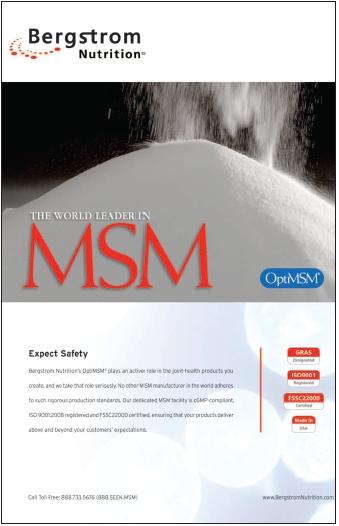 While they are not treatments, certain supplements and natural methods can offer support for sore, stiff joints. Though the options may be diverse, Kidd says the general approaches behind them are similar. Joint health supplements “support or enhance the healing of damaged joint tissues; help protect against further damage; calm down inflammatory mechanisms that are likely contributing to the joint degeneration. Inflammation is readily measured via blood levels of c-reactive protein (CRP) or interleukin-6 (IL-6),” he states.
While they are not treatments, certain supplements and natural methods can offer support for sore, stiff joints. Though the options may be diverse, Kidd says the general approaches behind them are similar. Joint health supplements “support or enhance the healing of damaged joint tissues; help protect against further damage; calm down inflammatory mechanisms that are likely contributing to the joint degeneration. Inflammation is readily measured via blood levels of c-reactive protein (CRP) or interleukin-6 (IL-6),” he states.
Having said that, Mount reminds us that “joints” are composed of several structures (e.g., tips of the bone, cartilage, ligaments, tendons and synovial fluid), and each responds better to specific supplements.
Improving mobility. Regaining lost mobility is a top priority for several shoppers, and the process can begin with cartilage support. Cartilage is made up of approximately 60% type 2 collagen and 40% glucosamine and chondroitin, says Mount.
To support healthy cartilage, Sugarek MacDonald starts us off with some of the best-known supplements in the category. First, glucosamine sulfate. The way it works, according to Sugarek MacDonald, is that it “stimulates the manufacture of cartilage components, as well as incorporating sulfur into cartilage.”
She adds, “Studies have shown that some people with mild to moderate OA taking glucosamine sulfate reported pain relief similar to nonsteroidal anti-inflammatory drugs. Some research indicates glucosamine may slow cartilage damage.”
Also integral to cartilage support is chondroitin sulfate, which binds to proteins like collagen and elastin in cartilage, tendons and ligaments. “In joints, it can contribute to strength, flexibility and even shock absorption,” says Sugarek MacDonald. “Chondroitin and its effects are thought to lead to cartilage regeneration by providing the body with missing elements of cartilage.” Thus, MSM or natural sulfur, is beneficial because it gives the body the sulfur it needs to make chondroitin sulfate.
A somewhat new form of chondroitin sulfate E is derived from Humboldt squid, and is said to be the first chondroitin shown in studies to selectively bind to midkines, which are responsible for pain and inflammation (10). Other types of chondroitin sulfates bind well to one MK receptor (PTPz), but this form does so faster and stronger, while inhibiting the migration of inflamed cells (10). It is also unique among chondroitins because it helps bone health by encouraging osteoblastic and osteocalcin formation, replication and expression.
Meanwhile, Mount believes that since cartilage is made of chondroitin sulfate, glucosamine sulfate and collagen, “a blend of all three supplements will help repair damaged cartilage.”
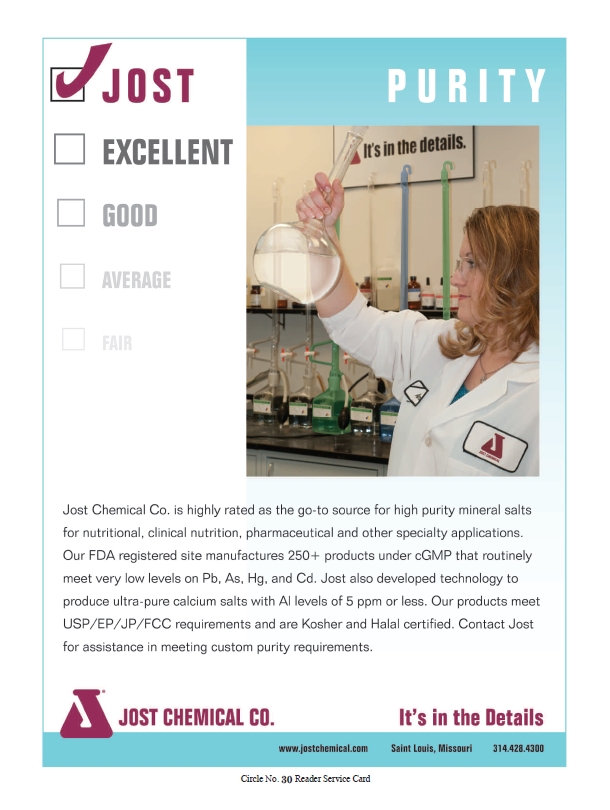 Park agrees that collagen is an important part of the picture. He says his firm’s branded ingredient (BioCell Collagen) offers a naturally occurring matrix of hydrolyzed collagen type 2, hyaluronic acid and chondroitin sulfate. He explains that it “can help facilitate the regeneration of degraded cartilage via stimulation of the chondrocytes that produce collagen and GAGs.” These molecules are essential for healthy connective tissues such as tendons and ligaments.
Park agrees that collagen is an important part of the picture. He says his firm’s branded ingredient (BioCell Collagen) offers a naturally occurring matrix of hydrolyzed collagen type 2, hyaluronic acid and chondroitin sulfate. He explains that it “can help facilitate the regeneration of degraded cartilage via stimulation of the chondrocytes that produce collagen and GAGs.” These molecules are essential for healthy connective tissues such as tendons and ligaments.
He feels supporting both collagen and GAGs is key, since OA is now viewed as much more than a condition brought on by wear and tear; it’s a complex interplay of neighboring tissues and pro-inflammatory agents. “This view necessitates a more comprehensive dietary approach to joint concerns than monotonous supplementation,” says Park. “An effective approach should interfere with both structural deterioration of the joint with its essential molecules in a bioavailable form and cellular aging processes such as senescence of the chondrocytes, with physiological stimulation for its regeneration together with reduced inflammation.”
Another collagen ingredient (undenatured type 2 collagen, UC-II from InterHealth Nutraceuticals) has been shown in studies to improve joint function. States Paul Dijkstra, CEO of InterHealth Nutraceuticals, Benicia, CA, “UC-II not only supports movement and comfort, but may help increase the ability to spend time with loved ones and enjoy life at its fullest.”
Dijkstra says his firm’s ingredient can do its job at a dose of 40 mg, even better than glucosamine combined with chondroitin (11). This could make a difference especially for people who cannot swallow large pills. “With compliance being a big factor for efficacy as well as repeat sales, it is important to make the regimen as convenient as possible for consumers,” he believes. “A product that combines UC-II with other joint health ingredients will still result in a manageable supplement size.”
Given that there are several types of collagen described here, it’s important to note Mount’s opinion that taking types 1 and 3 simultaneously with type 2 collagen will neutralize the benefits. “We suggest taking types 1 and 3 in the morning and type 2 at night,” says Mount.
Last, hyaluronic acid is well known to aid joint fluidity; vitamin C and manganese support collagen and cartilage synthesis; and SAM-e indirectly benefits cartilage regeneration.
|
Select Bone-Support Supplements American Health: Ester-C (1,000 mg) with D3 (5,000 IU). Bluebonnet Nutrition Corporation: Bluebonnet’s Liquid Calcium Magnesium Citrate in six flavors, Bluebonnet’s Osteo-Bone Formula Vcaps, Bluebonnet’s Calcium Citrate Magnesium Plus Vitamin D3 Caplets, and Bluebonnet’s Vitamin D3 products from lanolin and fish oils in multiple dosage forms and potencies. Doctor’s Best: Calcium Bone Maker Complex, Strontium Bone Maker. EuroPharma, Inc.: OsteoStrong, Vitamin D3 5,000 IU, Trica-Sil and Strontium. Membrell: BONEhealth Original. Natural Factors Nutritional Products, Inc.: BioSil and Healthy Bones Plus Natural Vitality: OsteoCalm and Natural Calm Plus Calcium NeoCell: NeoCell Super Collagen products, available in powder, tablets and liquid. Solgar: Magnesium Citrate Tablets, Liquid Calcium Magnesium Citrate with Vitamin D3 (in natural blueberry, orange-vanilla and strawberry flavors), Calcium Citrate with Vitamin D3 Tablets, Calcium Magnesium with Vitamin D3 Tablets, Chelated Magnesium Tablets, Calcium Magnesium Citrate Tablets and Calcium Magnesium Plus Zinc Tablets. Jarrow Formulas, Inc.: Bone-Up, Ultra Bone-Up, Bone-Up Three Per Day and Bone-Up (Vegetarian). Soft Gel Technologies, Inc.: Supplies several potencies (400 IU, 1,000 IU and 5,000 IU) of vitamin D3 in soft gelatin capsules.
Select Joint Health Supplements Bergstrom Nutrition: OptiMSM brand of methylsulfonylmethane. BioCell Technology, LLC: Biocell Collagen, Biocell Collagen CG. Bluebonnet Nutrition Corporation: Bluebonnet’s Glucosamine Chondroitin Plus MSM Vcaps, Bluebonnet’s Omega-3 Joint Formula Softgels , Bluebonnet’s Glucosamine Celadrin MSM Vcaps, Bluebonnet’s GSX Formula Vcaps, Bluebonnet’s Standardized Cherry Fruit Vcaps, Bluebonnet’s Standardized Turmeric Root Vcaps, Bluebonnet’s TrimologyLicorice Root Extract Vegetarian Softgels. Doctor’s Best: Doctor’s Best Glucosamine, Chondroitin, and MSM combinations; and Best Hyaluronic Acid with Chondroitin Sulfate. EuroPharma, Inc.: Curamin, Healthy Knees and Joints, Arthocin and CuraMed. Horphag Research: Pycnogenol. InterHealth Nutraceuticals: UC-II. Jarrow Formulas, Inc.: Joint Builder, Ultra Joint Builder, SAM-e Joint and InflaTame. Membrell: JOINThealth Original and JOINThealth Plus Antioxidants. Natural Factors Nutritional Products, Inc.: OsteoMove, Glucosamine-MSM Complex, CherryRich, Zymactive. Natural Vitality: Natural Calm. NeoCell: Neocell’s Joint Complex with Hyaluronic Acid (Type 2 Collagen, Glucosamine & Chondroitin) Solgar: Solgar No. 7 Vegetable Capsules, Extra Strength Glucosamine Chondroitin MSM with Ester-C Tablets, Extra Strength Glucosamine Chondroitin Complex Tablets, Extra Strength Glucosamine Chondroitin Complex Tablets, Glucosamine Hyaluronic Acid Chondroitin MSM (Shellfish-Free) Tablets, Extra Strength Glucosamine Chondroitin MSM (Shellfish-Free) Tablets. Topical BioMedics, Inc.: Topricin Pain Relief and Healing Cream, Topricin Foot Therapy and Topricin Junior. Proprietary Nutritionals Inc.: Celadrin, Vege-Celadrin and Perluxan. Soft Gel Technologies: Perluxan patented hops extract in softgels, Injuv (HA complex) with Glucosamine, several potencies of vitamin D in soft gelatin capsules, EZ Mega 3 softgels, Cod Liver Oil in softgels and various CoQ10 softgels (including CoQsol, CoQsol-CF and CoQH-CF). Sister raw materials company, OptiPure, offers a squid cartilage extract, branded as IncaCartilago. |
Inflammation support. To help reduce swelling, one may find some benefits from antioxidants. For instance, cherry extract has twofold benefits: it blocks COX 1 and 2 enzymes (which cause inflammation) and lowers uric acid levels (which is good news for those with gout). Sugarek MacDonald speaks of a study from the University of California, Davis that found daily intake of cherries reduced uric acid levels in women by 15%.
Murray also feels cherries and other sources of anthocyanidins and proanthocyanidins “are remarkable in their ability to prevent destruction to connective tissue and joints.”
He says new data on 633 gout patients were collected by Boston University School of Medicine researchers for a year (12). They found cherry intake for two days was associated with a 35% lower risk for gout attacks. Adds Murray, “The risk for gout attacks was reduced by 75% when cherry intake was combined with allopurinol, the standard drug used in the prevention of gout attacks.”
A second ingredient said to support joint health through its anti-inflammation properties is natural eggshell membrane. According to Dockery, “It naturally contains the building blocks for healthy joint tissue such as chondroitin sulfate and hyaluronic acid as well as collagen, glucosamine and a number of proteins and peptides.”
Also for inflammation, several industry insiders suggest curcumin. Sugarek MacDonald explains that curcumin inhibits inflammatory agents lipoxygenase, NF-KappaB and COX-2. She states, “By blocking the production of certain prostaglandins (hormone-like substances) and leukotrienes, curcumin has been shown in human studies to induce an anti-inflammatory reaction in the body, thus supporting joint health and mobility.”
Another interesting action of curcumin is to support healthy CRP levels. Kidd feels this fairly new finding about curcumin is significant. “Blood levels of CRP and IL-6 tend to be elevated in parallel with the severity of the joint degeneration,” he explains. “The levels of both these messenger substances tend to be a net outcome of active inflammation occurring anywhere in the body. Damage to the joints is likely worsened by inflammation that occurs anywhere else in the body, and vice versa.”
He cites research on a branded curcumin ingredient (MERIVA) indicating it lowered very high CRP levels to within healthy range after just three months (13).
Myers favors a high-absorption curcumin (like BCM-95) in combination with boswellia (as BosPure). This form of curcumin, she says, is 10% more absorbable than a typical curcumin because of its smaller particle size. Meanwhile, boswellia reduces inflammation by inhibiting the pro-inflammatory enzyme, 5-LOX. “BosPure screens out much of the beta-boswellic acid, which can potentially promote, rather than block, inflammatory compounds. And, it includes only those—specifically acetyl-11-keto-beta-boswellic acid (AKBA)—that really boost the effectiveness of the extract,” says Myers.
In one study, says Myers, “BCM-95 curcumin was found to be equal to the prescription rheumatoid arthritis drug, diclofenac sodium, but with fewer adverse effects, in a recent clinical study of rheumatoid arthritis” (14). In other research, the combination of BCM-95 curcumin and BosPure boswellia twice daily “was better than celecoxib in relieving pain, walking distance and joint line tenderness scores. It was also equally effective as celecoxib in alleviating crepitus, and range of joint movements” (15).
A separate branded boswellia serrata extract (5-LOXIN Advanced AKBA) is said to show improvement in joint comfort within seven days, according to Vrablic. Her company combines it with other ingredients (UC-II undenatured [active, whole and complete] collagen, and Ester-C with a complex of traditional pepper spices and botanicals) for joint support.
We also have to talk about hops cone extract for inflammation support. The maker of a branded form (Perluxan, from Pharmachem Laboratories) states on its Web site that the extract works with biochemical pathways responsible for inflammation, and it can help relieve pain quickly.
States Dean Mosca, president of Proprietary Nutritionals Inc., Kearny, NJ, “A clinical study of patients with knee pain showed Perluxan had a fast-acting effect on relieving discomfort and significant improvement over placebo after only two hours following the first dose.” He notes that a separate study found the extract to be comparable with ibuprofen for reducing pain-causing inflammatory enzymes.
Also available from the same company is a branded esterified fatty acid derived from bovine tallow oil that is known to reduce inflammation and support joint health. “In studies, both humans and animals have shown extensive reduction in pain and swelling and increased range of motion with Celadrin, with no reported side effects,” states Mosca. He says the ingredient inhibits inflammation in endothelial cells and decreases the pro-inflammatory effects of arachidonic and other fatty acids.
“Celadrin has also been shown to reduce the production of the negative immune factor IL-6 and to control the immune factors responsible for inflammation,” Mosca explains.
Fish oil also belongs in this category for reasons stated previously.
Another powerful inflammation-support extract is French maritime pine bark extract. Frank Schönlau, Ph.D., scientific director for Horphag Research, Hoboken, NJ, says that his company’s branded form (Pycnogenol) may directly help with pain. It works differently than a drug store pain medication, though. He states, “With painkillers, you may expect pain relief within 30–60 minutes, but the medication does nothing to improve the joints.”
While it may take a couple of weeks to feel a difference, the pain isn’t masked with Pycnogenol; one’s joint health is maintained with healthy cartilage and less inflammation, while requiring less pain medication. Adds Schönlau, “Research has also shown that mobility is improved and there is a noticeable improvement in joint stiffness as well.” In fact, 52% of knee OA patients experienced improved physical function, 43% had reduced pain and 35% had less stiffness after three months of taking the extract (16).
Another interesting new finding was that the extract significantly lowered CRP levels in OA patients who had elevated levels. “It is that potent anti-inflammatory activity of Pycnogenol that sets the stage for allowing the joint cartilage to recover, such as by dietary supplements providing ‘building blocks’ such as glucosamine, collagen and hyaluronic acid,” states Schönlau.
For more immediate pain support, topical products have been known to be beneficial. Paradise explains his company’s homeopathic creams help maximize homeostatic balance in joint, nerve and muscle tissue to resolve pain. Paradise says, “By keeping the joints healthy in a crisis/injury and in its role as a preventive (used before and after physical exertion), Topricin excels in its ability to maintain a natural detoxification at the cellular level while helping the body maintain healthy oxygen-rich blood to the cells, all of which are vital in maintaining bone and joint health. And, according to sports physiologists, Topricin also keeps the pathways open that are necessary for the body to deliver the nutrients to the joints.”
Immune modulation. Related to inflammation support, some joint problems are caused by an overactive immune response. Immune involvement, says Clouatre, “can occur due to overuse causing damage to cartilage that then recruits immune cells to the site, in turn bringing more inflammation. It also can occur, as in rheumatoid arthritis, due to auto-immune actions.”
He suggests that several supplements may support healthy immune function for joint care such as chondroitin, omega-3s, hyaluronic acid and Boswellia serrata extracts.
While they are not natural remedies for arthritis, they may provide some benefit to those with joint issues. WF
|
Finding Relief from Fibromyalgia By Amanda Willis A somewhat new syndrome has been making headlines in recent years: fibromyalgia (FM), a complex chronic pain condition that affects people physically, mentally and socially. Nena Dockery, the technical services manager of Membrell, explains, “FM is a painful and frustrating syndrome characterized by pain, fatigue and sleep disruption. The potential causes, manifestations and remedies are as diverse and as elusive as the condition itself.” There is no cure for FM and over-the-counter pain killers can only dull the pain. But, Rodney Benjamin, technical director for Bergstrom Nutrition, says natural remedies may have some benefits for improved function and pain. "While the cause of fibromyalgia is unknown, some of the deficiencies that are associated with it can contribute to its symptoms," he states. CoQ10 There may be a link between taking cholesterol-lowering medication and FM. Such drugs may deprive the body of CoQ10, which is found in our body’s cells and is used to produce the energy needed to support cell regrowth and maintenance. Jacob Teitelbaum, M.D., blogged in Psychology Today, “These medications are used long term to treat high cholesterol. But this may starve the body of CoQ10 and pregnenolone and can, therefore, flare CFS/FMS.” Teitelbaum adds FM patients can have their pregnenolone and cholesterol levels tests. “If either is low or low normal, add CoQ10 and pregnenolone supplementation to your diet,” he states. “Also add an omega-3 fish oil to help give your cell walls what they need while your body is blocking cholesterol production.” Many physicians agree that CoQ10 can benefit FM patients, but cannot cure it. “There have been some positive preliminary results observed after supplementation with CoQ10, and an indication that there might be a link between the disorder and vitamin D status,” Dockery says. Vitamin D Some studies indicate that a higher intake of vitamin D can decrease FM symptoms, and many FM patients have low levels. According to the Vitamin D Council, “Vitamin D may reduce the risk or symptoms of FM by lowering inflammation. Vitamin D reduces cytokine production. This protein causes inflammation. However, one study found that FM pain was not directly affected by these compounds.” Malic Acid and Magnesium Magnesium is one of the most important elements our bodies need. Among many jobs, it helps with fatigue, which many FM patients encounter. “The over-production of adrenaline due to stress leads to magnesium deficiency and therefore puts a strain on the magnesium dependent energy system of the body, causing energy depletions that leads to fatigue,” Carolyn Dean, M.D., N.D., author of The Magnesium Miracle, explains. “Fatigue is often reduced with magnesium supplementation. Of the enzyme systems that require magnesium, the most important ones are responsible for energy productions and storage.” Meanwhile, Dallas L. Clouatre, Ph.D., R&D consultant to Jarrow Formulas, Inc., explains, “FM is poorly understood and its treatment highly controversial. One argument is that local hypoxia leads to muscle pain. Malic acid supplements appear to give some relief.” Malic acid is found in food and helps produce energy in the body. It can also remove aluminum from the body. Aluminum toxicity is thought to be one contributor to fibromyalgia symptoms. Magnesium and malic acid are important for the body to create energy and helpful for FM patients. Dean explains, “In the case of FM, low magnesium keeps muscles in the state of spasm, so supplementation can aid in relieving the symptom.” Dean continues by looking at a study by Guy D. Abraham, M.D, who generated positive results in the reversal of FM with magnesium and malic acid supplementation. FM patients who took magnesium (300–600 mg) and malic acid (1,200–2,400 g) experienced pain relief in 48 hours. MSM Another way for FM patients to combat muscle cramps and tenderness is with MSM. States Benjamin, "Human studies have shown MSM may reduce muscle soreness following acute bouts of exercise. While the mechanism for this is not understood, neither is the cause of muscle pain in fibromyalgia patients." He says some preliminary studies indicate MSM "down regulates the expression of inflammatory cytokines which may be contributory to fibromyalgia." Plus, MSM may have some oxidative stress-reducing properties. Other Remedies Tropical products may also help FM patients with the pain. Lou Paradise, president and chief of research of Topical BioMedics, speaks of his firm’s cream: “The applications are on the ‘tender points’ at the front and back of the neck, trapeze muscle on the shoulders, the ribs front chest, the shoulder blades, the upper outer area of hips and buttocks, and around the knees. Women have reported to us that by using Topricin regularly they feel better and healthier, and are staying more active.” |
References
1. National Institute of Arthritis and Musculoskeletal and Skin Diseases, “Osteoporosis: Peak Bone Mass in Women,” www.niams.nih.gov/Health_Info/Bone/Osteoporosis/bone_mass.asp, accessed Dec. 20, 2012.
2. M.F. Holick, “Vitamin D: Important for Prevention of Osteoporosis, Cardiovascular Heart Disease, Type 1 Diabetes, Autoimmune Diseases, and Some Cancers,” South. Med. J. 98 (10), 1024–1027 (2005).
3. P.M. Kidd, “Vitamins D and K as Pleiotropic Nutrients: Clinical Importance to the Skeletal and Cardiovascular Systems and Preliminary Evidence for Synergy,” Alt. Med. Rev. 15: 199–222 (2010).
4. M.J. Bolland, et al., “Calcium and Vitamin D Supplements and Health Outcomes: A Reanalysis of the Women’s Health Initiative (WHI) Limited-Access Data Set,”Am. J. Clin. Nutr. 94 (4),1144–1149 (2011).
5. E. Warensjö, et al., “Dietary Calcium Intake and Risk of Fracture and Osteoporosis: Prospective Longitudinal Cohort Study,” BMJ, 342:d1473 (2011).
6. C. Dean, “Calcium Intake Without Magnesium Is a Health Risk,” www.nutritionalmagnesium.org/component/content/article/38-general-magnesium-health-information/354-calcium-intake-without-magnesium-is-a-health-risk.html, accessed Dec. 27, 2012.
7. M.H. Knapen, L.J. Schurgers and C. Vermeer, “Vitamin K2 Supplementation Improves Hip Bone Geometry and Bone Strength Indices in Postmenopausal Women,” Osteoporos. Int. 18 (7), 963–972 (2007).
8. Baylor College of Medicine, “Vitamin C Protects, Maintains Healthy Bone Mass,” www.bcm.edu/news/item.cfm?newsID=2218, accessed Dec. 27, 2012.
9. R.T. Chlebowski, et al., “25-Hydroxyvitamin D Concentration, Vitamin D Intake and Joint Symptoms in Postmenopausal Women,“ Maturitas. 68 (1), 73-78 (2011).
10. “Product Profile: OptiPure,” WholeFoods Magazine (3), 2011.
11. D.C. Crowley, et al., “Safety and Efficacy of Undenatured Type II Collagen in the Treatment of Osteoarthritis of the Knee: A Clinical Trial,” Int. J. Med. Sci. 6 (6), 312–321 (2009).
12. Y. Zhang, et al., “Cherry Consumption and the Risk of Recurrent Gout Attacks,” Arthritis Rheum. 2012 Sep 28. doi: 10.1002/art.346718 [Epub ahead of print].|
13. G. Belcaro, et al., Panminerva Medica 52: 1 (2010).
14. B. Chandran and A. Goel, “A Randomized, Pilot Study to Assess the Efficacy and Safety of Curcumin in Patients with Active Rheumatoid Arthritis,” Phytother. Res. 26 (11), 1719–1725 (2012).
15. B. Antony, et al., “Clinical Evaluation of an Herbal Formulation in the Management of Knee Osteoarthritis,” poster presented at the Osteoarthritis Research Symposium Internationale (OARSI) Annual World Congress on Osteoarthritis, San Diego, CA, September 15–18, 2011.
16. R. Farid, et al., “Pycnogenol Supplementation Reduces Pain and Stiffness and Improves Physical Function in Adults with Knee Osteoarthritis,” Nutr. Res. 27 (11), 692–697 (2007).
Published in WholeFoods Magazine, February 2013


